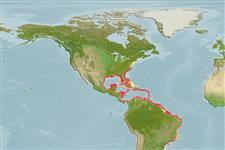Teleostei (teleosts) >
Eupercaria/misc (Various families in series Eupercaria) >
Lutjanidae (Snappers) > Lutjaninae
Etymology: Lutjanus: Malay, ikan lutjan, name of a fish.
More on authors: Bloch & Schneider.
Environment: milieu / climate zone / depth range / distribution range
Ecology
Marine; freshwater; brackish; reef-associated; depth range 2 - 40 m (Ref. 58047), usually 5 - 30 m (Ref. 9710). Subtropical; 42°N - 26°S, 98°W - 14°W (Ref. 55232)
Western Atlantic: Massachusetts, USA to São Paulo, Brazil (Ref. 57756), including the Gulf of Mexico and the Caribbean Sea (Ref. 9626). Eastern Atlantic: St. Paul's Rocks and Ascension Island (Ref. 13121), Tinhosa Grande, south of Príncipe Island (L.A. Pereira (pers. comm.).
Length at first maturity / Size / Weight / Age
Maturity: Lm 32.4, range 31 - 36 cm
Max length : 128 cm TL male/unsexed; (Ref. 40637); common length : 60.0 cm TL male/unsexed; (Ref. 26938); max. published weight: 28.6 kg (Ref. 40637); max. reported age: 33 years (Ref. 115050)
Dorsal spines (total): 10; Dorsal soft rays (total): 14 - 15; Anal spines: 3; Anal soft rays: 8. Preopercular notch and knob weak. One of the pairs of canines in upper jaw notably enlarged, visible even when mouth is closed. Pectoral fins long, reaching level of anus. Scale rows on back rising obliquely above lateral line. Presence of a triangular bar between lower edge of eye and rear of mouth. Back and upper sides olive brown with bronze tinge, sometimes with narrow pale bars; lower sides and belly light reddish with a copper tinge. Young with a horizontal blue line below eye which breaks into a row of spots in adults.
Adults are common around rocky or coral reefs. Young are found in estuaries and occasionally enters rivers. Feed mainly on fishes and benthic invertebrates, including shrimps, crabs, gastropods and cephalopods.
Life cycle and mating behavior
Maturity | Reproduction | Spawning | Eggs | Fecundity | Larvae
Allen, G.R., 1985. FAO Species Catalogue. Vol. 6. Snappers of the world. An annotated and illustrated catalogue of lutjanid species known to date. FAO Fish. Synop. 125(6):208 p. Rome: FAO. (Ref. 55)
IUCN Red List Status (Ref. 130435: Version 2024-1)
Threat to humans
Reports of ciguatera poisoning (Ref. 55)
Human uses
Fisheries: commercial; gamefish: yes; aquarium: public aquariums
Tools
Special reports
Download XML
Internet sources
Estimates based on models
Preferred temperature (Ref.
123201): 23.2 - 28, mean 25.8 °C (based on 522 cells).
Phylogenetic diversity index (Ref.
82804): PD
50 = 0.5000 [Uniqueness, from 0.5 = low to 2.0 = high].
Bayesian length-weight: a=0.01514 (0.01339 - 0.01711), b=2.97 (2.95 - 2.99), in cm total length, based on LWR estimates for this species (Ref.
93245).
Trophic level (Ref.
69278): 4.4 ±0.3 se; based on diet studies.
Generation time: 11.0 ( na - na) years. Estimated as median ln(3)/K based on 1
growth studies.
Resilience (Ref.
120179): Low, minimum population doubling time 4.5 - 14 years (K=0.10; tm=5.5).
Prior r = 0.28, 95% CL = 0.19 - 0.42, Based on 1 data-limited stock assessment.
Fishing Vulnerability (Ref.
59153): High to very high vulnerability (66 of 100).
Nutrients (Ref.
124155): Calcium = 11.5 [5.9, 19.1] mg/100g; Iron = 0.269 [0.156, 0.499] mg/100g; Protein = 19.6 [18.0, 20.9] %; Omega3 = 0.176 [0.097, 0.305] g/100g; Selenium = 28.8 [13.9, 56.2] μg/100g; VitaminA = 96.7 [15.9, 482.1] μg/100g; Zinc = 0.254 [0.176, 0.396] mg/100g (wet weight);
